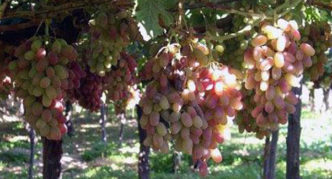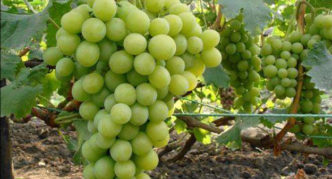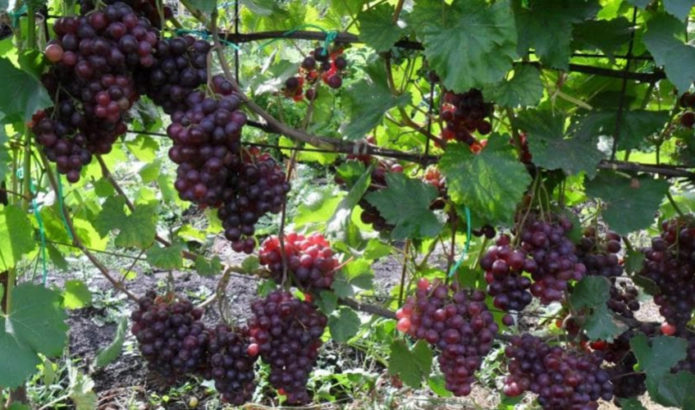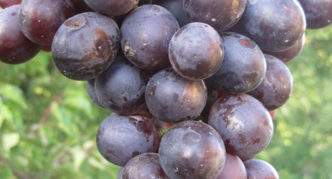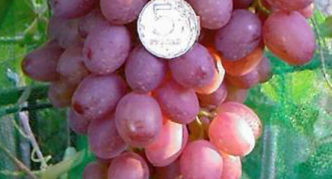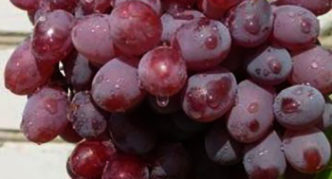Winegrowers know that there are many varieties of this precious vine - about ten thousand. Each of them has its own advantages and disadvantages. But there are those among them that even those who have never seen a vine, but love its sun-filled fruits, know about. One of these varieties is Cardinal.
Content
From the history of his eminence
The cardinal was born back in 1939 on the overseas land of the United States. This grape was bred in California by breeders E. Snyder and F. Harmon. For a long time it was believed that the grape varieties Alphonse Lavalier were crossed with Flame Tokay, but as shown by genetic analysis, this was not true. Not Flame Tokay, but the Queen of the Vineyards was in the Cardinal's parent couple.
Cardinal's real and imaginary parents
- Alphonse Lavalier variety
- Flame Tokay variety
- Variety Queen of the vineyards
After traveling across the ocean, the Cardinal conquered the southern countries of Europe, and later from France came to the lands of post-Soviet countries. Here it quickly spread to the southern regions.
Since 1966, Cardinal has been at the state variety testing at the Federal State Budgetary Institution "State Variety Commission". In 1974, she recommended growing it in the North Caucasus region, and in 2004 - in the Nizhne-Volzhsky.
Portrait of the Cardinal
The cardinal has a dining function. This grape is very early maturing - 105 days. Its bunches are loose, elongated, cylindrical, converging on a cone. Their weight ranges from 150-200 g to 900 and more. They consist of large oval berries with a thin skin. The prune is clearly visible on it. The cut weight of the berries is 5–6 grams, but large berries reach up to 20 grams. When ripe, the berries acquire a dark color in the range of red and purple tones. Berry juicy pulp of light green color with a pleasant taste and a slight aroma of nutmeg. Tasters rate the Cardinal's taste at 8-9 points. There are 2-4 large enough seeds inside the grape. Sugar in Cardinal berries contains up to 18%, and acids - 6–8 grams per liter of juice. From one hectare, you can get a crop of 14-18 tons.
It has a very low winter hardiness and easily picks up diseases, but it is fruitful, well transported and stored for up to three months. At the same time, in years with severe weather conditions during flowering, flowers and ovaries easily crumble, peas in bunches are actively manifested.
One of my favorite varieties. Very large berries (some reach 18–20 g), large clusters only on powerful formations - 1.500. The local grower has a Cardinal bush giving up to 200 kg! It occupies a whole gazebo and is very old and powerful, the sleeve of which is dug around to form additional roots.
The pulp of the Cardinal is unmistakable - crispy when biting off, fleshy and juicy, with tender nutmeg. Believe me - having a lot of grape varieties on the site, but I always enjoy its taste.After eating different varieties on the site, I come into the house and, having ripped off the Cardinal's brush, I eat it with pleasure. The berries are covered in such a light smoky prune. It is juicy and dense at the same time, and sweet and not cloying. Probably, it's like bread - it doesn't get bored, it always eats with pleasure, although there are many different delicious pastries around. If the professional winegrowers have the term "classic" - it is about the Cardinal. I think so.
It is not resistant to fungal diseases, but I cannot say that I spray it additionally. As well as other varieties. It's just that there are no unstable varieties around him - he also "holds on" and tries not to get sick. Although the stepchildren on the tops of the vines can pick up mildew or powdery mildew in the fall, the vine is already ripe by this time and is not affected. I cover for the winter as well as other varieties - no more.
I think so - an attentive grower who has picked up a key to this variety will be glad to have it on his site, and the variety will thank him with beautiful, tasty berries.
Cardinal Grape (Classic, Californian)
Cardinal's namesake
On the basis of the Cardinal variety, which has many positive qualities, new grapes have been bred that bear his name. Among them:
- clones numbered 80–87, bred in France in 1971;
- suite;
- AZOS;
- Crimean;
- sustainable (Bulgarian);
- Moldovan (1-5-58);
- V-42/82 and others.
Gallery of Cardinals
- Cardinal deluxe obtained by crossing Cardinal with Criuleni
- Resilient Cardinal ripens early - in 115-120 days
- This variety was created in Anapa
- This variety of Cardinal ripens superrano - in 100-105 days
- The vines of the Moldavian Cardinal vines are medium
- This hybrid was created in Bulgaria
Cardinal suite
Cardinal deluxe is obtained by crossing Cardinal with Criulensky. He surpassed his predecessor in resistance to fungal and other diseases of grapes and frost resistance, but yielded to him for the duration of the ripening of the crop. Lux matures in 115–125 days.
The bushes of Cardinal Lux are growing very actively. The bunches are large with an average weight of 450 grams, and separate ones - up to 1 kilogram or more. Berries weighing an average of 7-9 grams are also considered large, but some of them gain even 20 grams. The skin of ripe grapes has colors ranging from red to very dark blue. Grapes of sweet taste with a nutmeg hue, it is estimated by tasters at 8.9 points. Cardinal contains sugar 17-21%, acids 6-8 grams per liter of juice. Harvest grapes.
Cardinal AZOS
Another type of Cardinal was created in Anapa. Breeders have achieved a significantly greater tolerance of the variety to cold temperatures down to -23 ° C and resistance to diseases, but its ripening period increased to 120–130 days. This medium-ripening table grape has vigorous growing vines with maximum shoot maturity along almost the entire length. Large, not very dense clusters are formed into a cone or cylinder converging on a cone. Their average weight is 450 grams, but bunches of a kilogram or more are not uncommon. Round large berries (7-9 g), when ripe, become red-purple, dark pink or dark blue. They contain up to 22% sugar and up to 10 grams of acid in a liter of juice. Their pulp tastes good with a nutmeg aroma.
Cardinal moldavian (1-5-58)
This Cardinal takes longer to mature than those listed earlier, from 125 to 135 days from the start of the growing season. Its bunches, without losing their taste, can remain on the vine until freezing, and in rainy weather the berries do not burst.
The vines of the Moldavian Cardinal vines are average. It can be grown on arches or trellises, but the grapes must be covered for the winter. Large clusters of Moldovan Cardinal weigh an average of 500 grams, but individual clusters can weigh one and a half kilograms. They consist of large berries of red-violet shades, weighing on average 7-9 grams, and the largest - 20 grams each. They taste sweet with a slight touch of nutmeg and contain 16-18% sugar. The harvested crop can be successfully transported or stored until spring.Cardinal Moldavian can withstand winter low temperatures down to -24 ° С.
Crimean cardinal
This variety of Cardinal ripens super early - in 100-105 days, is widely used in industrial plantings of the Crimea. The Crimean cardinal tolerates cold temperatures down to -22 ° C and is more resistant to diseases typical of grapes. Its large pink berries are round. They are collected in loose tapered brushes, which, with proper care, can gain kilogram weight. The sweet taste of the fruit is complemented by bright nutmeg. The tasters rated the taste of the fresh berries of the Crimean Cardinal lower than the original form. He received only 8.1 points. The vineyard must be protected from birds, which, if possible, actively peck berries.
Cardinal steady
About the origin of this hybrid form there is only an assumption that it belongs to the family of grapes obtained by crossing the Cardinal with the Criuleni grape. Stable ripens early - in 115–120 days. Bushes of this variety have strong growth, flowers are bisexual, young shoots ripen well. Bunches in the form of a cylinder are large, often of medium density, but sometimes dense. They weigh on average from 500 to 900 g. Large round massive berries weighing 7-10, and some up to 20 grams, have a slightly flattened shape. The dense pulp filled with juice is covered with a pink-purple skin imperceptible in food. A light nutmeg flavor complements the pleasant taste of grapes, rated by the tasters at 8.9 points. The sugar content of the variety is 17-19%, the acid content is 5-6 grams per liter of juice. Cardinal resistant can be successfully transported without loss of quality. Its frost resistance is -22 ° С. This grape is unstable to mildew disease, and average resistance to mildew.
Cardinal V-42/82
This hybrid was created in Bulgaria. To obtain it, the Cardinal was crossed with the Muscat de Saint-Valier variety. V-42/82 ripens in 115-125 days. The bushes grow vigorously and have a satisfactory shoot maturity. But this variety does not tolerate frosts below -20 ºС, and in regions with low temperatures, the immature growth may die in winter. The large bunches weighing 500-600 grams are composed of large dark red berries with an average weight of 6-7 grams. This hybrid form is outwardly similar to the Californian selection Cardinal, but the V-42/82 berries are not peeled. The sugar content in the berries of Cardinal V-42/82 is 16-17%, the acid content is 6-7 grams per liter. One hectare can harvest 14-18 tons of berries. disease resistance of the variety is low - 2.5–3 points.
So that the Cardinal grows and pleases you
The best option for cultivating Cardinal is a climate with not very cold winters, but proper care allows you to grow it in the regions corresponding to the variety. It is best to plant these grapes on black soil. He feels good on loam and sandy loam soils.
Cuttings or seedlings of the Cardinal should be planted in the most illuminated and warmed up place by the sun. It is better to do this in spring, since the variety is not winter-hardy, even a covered young vine can be damaged by the winter cold. It is necessary to place a seedling on the site as soon as possible, but only after the ground warms up to +10 ºС. If more than one Cardinal bush is planted, then 2.5-3 meters are left between them. When planting several rows of grapes, the distance between them should be about 2–2.5 meters. The rest of the planting is the same as for other grape varieties:
- the pit is dug with the overall dimensions of 80–100 cm;
- if the soil nutrient is low, 1–2 buckets of organic matter are placed on the bottom of the pit and covered with a layer of earth;
- the support stake is hammered in the center of the pit;
- a soil mound is poured to accommodate the roots of the seedling;
- the roots of the seedling are straightened and covered with a layer of soil;
- the soil is compacted neatly, the sides for irrigation are formed;
- the seedling is watered with two or three buckets of cold water.
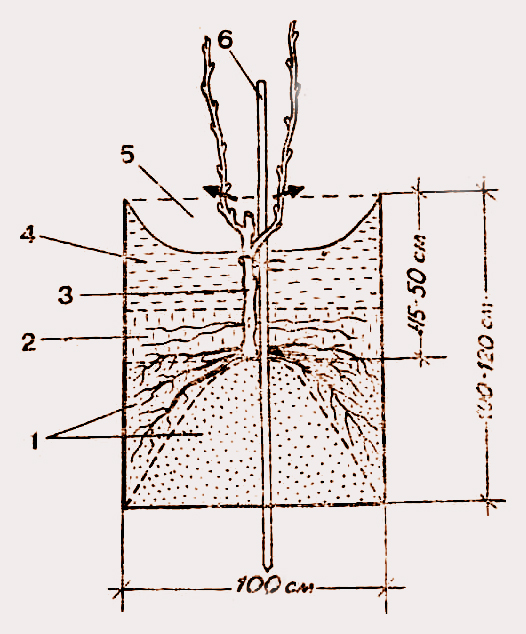
Cuttings or seedlings of the Cardinal should be planted in the most illuminated and warmed place by the sun
To the cardinal, both excess and lack of moisture are harmful.With a high density of soil, poorly absorbing moisture, drainage should be provided so that the water does not stagnate.
Three watering is mandatory for grapes - before and after flowering, and a month before harvesting, it is advisable to perform strictly. The rest of the time, the frequency of watering directly depends on the weather.
The normal growth of the plant and its stable yield can be ensured only by using fertilizers. During the season, fertilizers are applied three times, strictly following the instructions for them:
- in early spring, to ensure active growth, plants are given nitrogen fertilizers (urea, nitroammophoska or others);
- after flowering and after harvesting - phosphorus and potassium (superphosphate, potassium sulfide or others).
Organic fertilizers are applied once every two years in the fall.
Cardinal is not resistant to fungal diseases, therefore, before and after flowering, the bushes are treated with fungicides in accordance with the instructions for them.
The Cardinal takes shelter especially carefully for the winter. Straw, hay and other covering materials will be useful here.
Cardinal's positive and negative
The Cardinal grape is certainly not perfect. Even the varieties described above, close to him, are inferior to him in some parameters, but superior in others. The main advantages of the Cardinal variety undoubtedly include:
- large berries with excellent taste;
- the size and beauty of the bunches;
- consistently high yield;
- the ability of berries and bunches to endure long-term transportation;
- the safety of the crop up to three months without loss of quality.
But the Cardinal also has considerable drawbacks.
The first of these is, of course, low resistance to winter cold. This sharply limits the range of distribution of the variety, the possibility of growing it in regions with a cold climate.
The second drawback, also related to the weather, is shedding of flowers and a large number of small berries (peas) in clusters in rainy weather.
The third undoubted drawback of the variety is its susceptibility to fungal and bacterial diseases, gray rot. True, this drawback of the Cardinal can be completely eliminated by careful care and timely processing, as is the case with experienced winegrowers.
Winegrowers reviews
I, too, is growing a Cardinal, seemingly not to / u. I would not say that he is very sick. Stably produces large clusters with large berries, no peas. Extraordinary taste with light nutmeg.
Two Cardinals have been planted on my site. One California got from my grandfathers. A real classic, tasty, beautiful, moderately capricious - this year I just burst a little. In terms of stability, it is no different from others, in a common team. The second one is from Krasokhina Svetlana Ivanovna - Cardinal is stable. This year gave signal clusters. Unlike the classic bunch, the bunch is denser, the berry is dark pink in color. It ripens later, the flesh is firm, the taste is simple. Dignity did not burst at all. With all respect, Andrew
This season K-81 in our vineyard did not bear fruit badly with short pruning: as an experiment, it left 3-4 buds. I did not feel any difference in yield: as always, the berry was tasty with a crunch, and this summer the nutmeg was not as pronounced as it used to be ... In August at night the temperature dropped to + 7 + 9. This is rare in the Kuban. I believe that this is why all the grapes took on a more intense color: the same K-81 compared to last year. But his nutmeg is really lost when overripe. I try not to overexpose these grapes on the bushes for more than two weeks.
The Cardinal grapes are not easy to grow, but if you wish, you can find an approach to it and grow this wonderful vine, which will thank you for your work with wonderful bunches of delicious berries.

